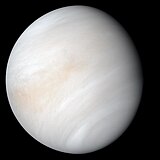Fiùra:PIA23791-Venus-RealAndEnhancedContrastViews-20200608 (cropped).jpg
Aspetto

Dimenziune 'e sta anteprimma: 600 × 600 pixel. Ati resoluziune: 240 × 240 pixel | 480 × 480 pixel | 768 × 768 pixel | 1 096 × 1 096 pixel.
File 'e origgine (1 096 × 1 096 pixel, dimenzione ddo file: 30 KB, tipo MIME: image/jpeg)
Cronologgia d’’o file
Fa’ clic ncoppa a na data/ora pe vedé comme s'appresentava 'o file a chillo mumento.
| Data/Ora | Miniatura | Dimenzione | Utente | Commento | |
|---|---|---|---|---|---|
| attuale | 00:40, 10 lug 2020 |  | 1 096 × 1 096 (30 KB) | PhilipTerryGraham | File:PIA23791-Venus-RealAndEnhancedContrastViews-20200608.jpg cropped 51 % horizontally using CropTool with precise mode. |
Jonte ê ffiure
Pe sta paggena ce buò stu file:
Auso globbale d’’o file
'E wiki ccà abbascio aúsano stu file:
- Uso ncopp'a ary.wikipedia.org
- Uso ncopp'a arz.wikipedia.org
- Uso ncopp'a ast.wikipedia.org
- Uso ncopp'a as.wikipedia.org
- Uso ncopp'a awa.wikipedia.org
- Uso ncopp'a azb.wikipedia.org
- Uso ncopp'a az.wikipedia.org
- Uso ncopp'a ban.wikipedia.org
- Uso ncopp'a bat-smg.wikipedia.org
- Uso ncopp'a ba.wikipedia.org
- Uso ncopp'a bcl.wikipedia.org
- Uso ncopp'a be-tarask.wikipedia.org
- Uso ncopp'a be.wikipedia.org
- Uso ncopp'a bew.wikipedia.org
- Uso ncopp'a bg.wikipedia.org
- Uso ncopp'a bh.wikipedia.org
- Uso ncopp'a bjn.wikipedia.org
- Uso ncopp'a bn.wikipedia.org
- Uso ncopp'a bo.wikipedia.org
- Uso ncopp'a br.wikipedia.org
- Uso ncopp'a bs.wikipedia.org
- Uso ncopp'a btm.wikipedia.org
- Uso ncopp'a bxr.wikipedia.org
- Uso ncopp'a ca.wikipedia.org
- Uso ncopp'a cdo.wikipedia.org
- Uso ncopp'a ceb.wikipedia.org
- Uso ncopp'a ce.wikipedia.org
- Uso ncopp'a chr.wikipedia.org
- Uso ncopp'a ckb.wikipedia.org
- Uso ncopp'a co.wikipedia.org
- Uso ncopp'a crh.wikipedia.org
- Uso ncopp'a cr.wikipedia.org
- Uso ncopp'a csb.wikipedia.org
- Uso ncopp'a cs.wikipedia.org
- Uso ncopp'a cu.wikipedia.org
- Uso ncopp'a cv.wikipedia.org
- Uso ncopp'a cy.wikipedia.org
- Uso ncopp'a dag.wikipedia.org
- Uso ncopp'a da.wikipedia.org
- Uso ncopp'a de.wikipedia.org
- Uso ncopp'a dga.wikipedia.org
- Uso ncopp'a din.wikipedia.org
- Uso ncopp'a diq.wikipedia.org
- Uso ncopp'a dsb.wikipedia.org
- Uso ncopp'a dty.wikipedia.org
- Uso ncopp'a el.wikipedia.org
Vedite ause globbale 'e stu file.




